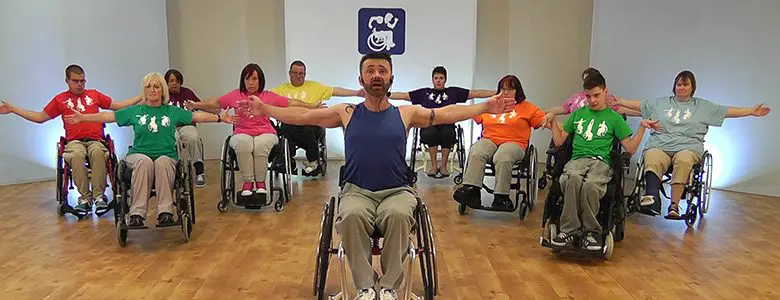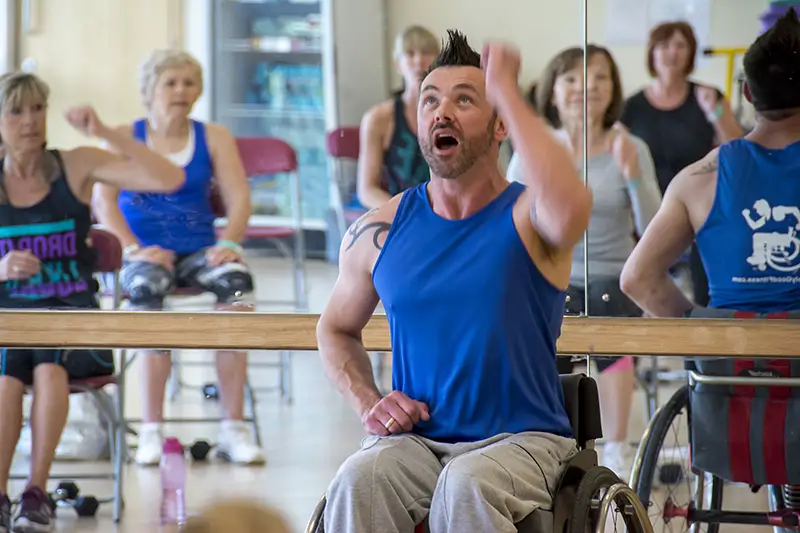
Wheely Good Fitness: exercise customised for wheelchair users
There are very few fitness centres that take into account the needs and abilities of individual disabled clients. Kris Saunders-Stowe, a wheelchair user due to a degenerative condition, was frustrated by this so founded Wheely Good Fitness – sport and workout adapted to the needs and aspirations of disabled people.
Kris tells Disability Horizons about the challenges he has faced, how Wheely Good Fitness works, and his tips on how you too can get fit and healthy if you have a disability.
Please could you tell Disability Horizons readers a bit about your company?
Wheely Good Fitness provides a modern approach to fitness for clients living with a disability. The idea to start the business came to me when I was faced with the choice of either using a wheelchair or becoming ‘trapped’ in my home due to a degenerative condition affecting my ability to walk unaided.
My initial response to the idea of using a chair was not polite or positive. However, after having to use one to attend an event, I realised my stubbornness was foolish as a wheelchair meant that there was so much I was able to do again.
But it also made me realise how little is available to wheelchair users who seek to improve their pushing abilities and fitness levels. What was on offer was extremely tame and more of a token gesture when compared to the choices available to able-bodied clients, which for me was extremely frustrating.
One day, the idea of becoming a fitness instructor popped into my head. It mean I would be able to not only change perceptions of disabled people but also be able to get a job I enjoyed and was able to do as a wheelchair user.
After completing a Gym & Fitness Instructor qualification I became a Disability Programmer, which enabled me to work with disabled clients. To broaden my horizons further I obtained Group Indoor Cycling, Circuit Training and Exercise to Music qualifications. To qualify I had to demonstrate my ability to teach able-bodied clients. After I qualified I was in a position to adapt general fitness principles to disabled clients’ needs.
How did you come up with the name, Wheely Good Fitness?
The name actually came about by accident. My partner and I were going through different ideas but nothing was appealing to me. I was getting frustrated and said; ‘I want something that sounds really good…’ I followed that sentence with: ‘or should that be something “wheely” good?’ and laughed. That was the moment that what started as a joke turned out to be perfect and stuck.
What challenges did you face when setting up your company?
The main challenges were the same as for any business really – getting known and established and getting by financially. However, there was and still the challenge of getting people and fitness centres to see beyond the preconceived ideas of what disabled people can do.
No matter what you say people still hear ‘chair exercise’ and think slow and gentle. To address this idea we have had to do a lot of demonstrations, and when we do, people are amazed at how intense our workouts are.
The challenge from an individual’s perspective is removing barriers that have been put in place by bad experiences of ‘inclusive’ exercise and by the lack of understanding of disability and its impact on individuals.
What challenges do you face being a disabled exercise instructor?
The main challenge is not being able to physically demonstrate everything to clients. You need to be more verbal and descriptive. Another problem I have is one that many wheelchair users experience when attending a gym – getting around it because of cramped layouts, something that needs to be addresses.

What has been the highlight of your career so far?
Over the last 18 months there have been some fantastic experiences: London Marathon, attending 10 Downing Street and performing in Westminster Hall. There is however one moment that for me that tops it all and that was when a client of mine crossed the finish line of this year’s first mass participation ParaTri Series.
This lady started attending the aerobics classes 18 months ago – she was unable to sit upright in her chair or open her right hand to push her chair because of cerebral palsy. Slowly her posture improved, as did her range of movement. After three months she sat more upright and started to open her hand as well as raise weights above shoulder height.
She asked if she could attend Wheel-Spin (a self propelling wheelchair class) and I said she would need to be able to self-propel in order to attend. Over time she managed to open her hand enough to grab her wheel; I then agreed for her to come to the cool down section of Wheel-Spin.
As the weeks went by, her abilities improved more and more until she was doing the entire class. This lady had wanted to become an athlete since childhood. She crossed the finish line after 11 minutes and 4 seconds beaming with pride, finally an athlete at 60 years of age. I can’t imagine anything ever beating what I felt that day – a journey I was honoured and privileged to be a part of.
What are the things you need to consider when teaching people with physical disabilities?
The main consideration is how an individual’s disability impacts on their ability to perform the movements and on their health. Many things, such as body temperature regulation, blood pressure and energy levels can be affected by a disability, medical condition or medication so these are factors that have to be considered.
Disability affects everyone differently – people face their own challenges within the class environment and beyond. It is important that those taking part are not over-worked as they need to be able to function after classes.
How do you adapt your exercises to work around various disabilities?
My main aim is for everyone to take part on an equal footing and to feel they are getting as much out of the class as the next person.
I tend to teach the class and observe the differences throughout the group and then offer adaptations to a move to the whole class instead of singling out one person. At the end of a class, if there is something specific I have noticed I will speak one-to-one to the person concerned.
What type of classes do you run?
I teach four main classes at the moment: Wheel-Fit, Aero-Fit, Wheel-Spin and an MS & Gentle Mobility class. Wheel-Fit and Aero-Fit are high energy seated aerobics classes – Wheel-Fit is run through Wheely Good Fitness and Aero-Fit through Halo Leisure.
Wheel-Spin is a high energy cardio workout for self-propelling wheelchair users. The MS & Gentle Mobility class is also taught through Halo Leisure and is a low energy flexibility class focusing on maintaining and improving mobility and co-ordination.
What advice would you give disabled people who wish to be fit and healthy, but don’t know where to go or where to start?
See if you have a leisure centre, classes or centres nearby that are either IFI (Inclusive Fitness Initiative) accredited or disability ‘friendly’. This means they have been assessed on their ability to provide services to clients with a disability. Information on your local providers can be found via efds.co.uk.
Another good thing to do is visit your local leisure centres with a friend to see what the premises, facilities and staff are like. Look at the exercise programmes they have on offer and ask what each one involves. Ask if you can pop along and observe to see if it’s something you feel you could do and perhaps speak to the instructor to see if you feel comfortable with them.
If finances allow, you could work with a personal trainer. They can put a personalised programme together for you to do at home or in a one-to-one session at a gym.
If none of these ideas appeal, you could personally aim to increase the amount of exercise you do by pushing a little further each day to the shops, park or work, or by moving around the house more each day.
What are your top five fitness tips?
1. Keep your goals achievable – if you aim too high at the beginning you will never feel as though you are getting anywhere and give up.
2. Exercise should be enjoyable and not a chore – keep it interesting, if you find it boring change what you are doing.
3. Flexibility and stretching is just as important as exercise. Walking with crutches, using a wheelchair and needing to move differently can cause our posture to change and the range of movement we have can deteriorate. Regular stretching can improve our flexibility and range of movement enabling us to do more generally.
4. Don’t over do it – pushing yourself too hard won’t make things happen quicker and may have a negative impact on your health. Your body needs time to adjust and recover enabling you to become fitter and stronger long term so listen to it!
5. Keep progressing – when you find something is starting to get easier, step it up. Walk or push a little further, increase the weights you are lifting a little or add in some new exercises.
Interview by Zubee and edited by Karen Mogendorff
You can find out more about Kris’s classes by visiting his website, www.wheelygoodfitness.com. He also runs Aero-Fit classes for Halo Leisure (www.haloleisure.org.uk). You can also buy Kris’s Wheel-Fit DVD on Amazon.
Get in touch by messaging us on Facebook, tweeting us @DHorizons, emailing us at editor@disabilityhorizons.com or leaving your comments below.
